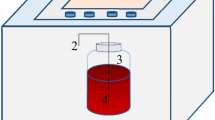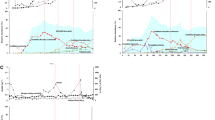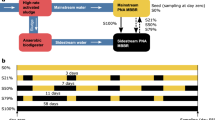Abstract
Nutrient removal from wastewater is crucial for global wastewater recycling and sustainable reuse. However, traditional methods for nitrogen and phosphorus removal face limitations in terms of energy consumption, operational complexity and environmental impact. Here we develop a floc management strategy to integrate anammox and enhanced biological phosphorus removal (EBPR) processes in a single-stage hybrid system (biofilms and flocs). This integrated approach resolves the conflicts between anammox and EBPR processes concerning ecological niche and solid retention time, enabling ultraefficient nitrogen and phosphorus removal efficiencies of 97.7 ± 1.3% and 97.4 ± 0.7%, respectively, in low-carbon municipal wastewater treatment. Notably, anammox benefitted from substrate competition with endogenous denitrification (both nitrite and nitrate) with floc loss, resulting in a significant enrichment of anammox bacteria in biofilms (12.5%) under mainstream conditions. Meanwhile, controlling floc concentrations at around 1,000 mg l−1 could maintain low polyphosphate levels in flocs, effectively addressing the additional phosphorus removal burden imposed by the enrichment of phosphorus-accumulating organisms in biofilms. This work offers a transformative solution to the long-standing challenge of integrating anammox and EBPR, paving the way for more sustainable and energy-efficient nutrient removal in wastewater treatment.
This is a preview of subscription content, access via your institution
Access options
Subscribe to this journal
Receive 12 digital issues and online access to articles
$119.00 per year
only $9.92 per issue
Buy this article
- Purchase on SpringerLink
- Instant access to full article PDF
Prices may be subject to local taxes which are calculated during checkout






Similar content being viewed by others
Data availability
The data generated in this study are provided within the article and its Supplementary Information. Raw sequencing data have been archived in NCBI Sequence Read Archive with the accession number SRR27602558-27602564. Source data are provided with this paper.
References
Kumar, R. & Pal, P. Assessing the feasibility of N and P recovery by struvite precipitation from nutrient-rich wastewater: a review. Environ. Sci. Pollut. Res. 22, 17453–17464 (2015).
Kartal, B., Kuenen, J. G. & van Loosdrecht, M. C. Sewage treatment with anammox. Science 328, 702–703 (2010).
Du, R., Cao, S., Zhang, H., Li, X. & Peng, Y. Flexible nitrite supply alternative for mainstream anammox: advances in enhancing process stability. Environ. Sci. Technol. 54, 6353–6364 (2020).
Lu, L. et al. Wastewater treatment for carbon capture and utilization. Nat. Sustain. 1, 750–758 (2018).
Wang, Z. et al. A loading rate switch strategy for stable nitritation in mainstream municipal wastewater. Nat. Sustain. 7, 305–314 (2024).
Akansha, K., Majumder, S., Misra, M. & Sachan, S. G. in Wastewater Treatment (eds Shah, M. et al.) Ch. 4 (Elsevier, 2021).
Hussain, A., Kumari, R., Sachan, S. G. & Sachan, A. in Microbial Ecology of Wastewater Treatment Plants (eds Maulin, S. & Rodríguez-Couto, S.) Ch. 8 (Elsevier, 2021).
Kang, D. et al. Toward Integrating EBPR and the short-cut nitrogen removal process in a one-stage system for treating high-strength wastewater. Environ. Sci. Technol. 57, 13247–13257 (2023).
Semerci, N. & Hasılcı, N. B. Fate of carbon, nitrogen and phosphorus removal in a post-anoxic system treating low strength wastewater. Int. Biodeterior. Biodegrad. 108, 166–174 (2016).
Strous, M., Heijnen, J. J., Kuenen, J. G. & Jetten, M. S. M. The sequencing batch reactor as a powerful tool for the study of slowly growing anaerobic ammonium-oxidizing microorganisms. Appl. Microbiol. Biot. 50, 589–596 (1998).
Zhang, L. et al. Maximum specific growth rate of anammox bacteria revisited. Water Res. 116, 296–303 (2017).
Wang, D. et al. Achieving stable nitritation for mainstream deammonification by combining free nitrous acid-based sludge treatment and oxygen limitation. Sci Rep 6, 25547 (2016).
Li, J. et al. Quantify the contribution of anammox for enhanced nitrogen removal through metagenomic analysis and mass balance in an anoxic moving bed biofilm reactor. Water Res. 160, 178–187 (2019).
van der Star, W. R. et al. Startup of reactors for anoxic ammonium oxidation: experiences from the first full-scale anammox reactor in Rotterdam. Water Res. 41, 4149–4163 (2007).
Cao, S. et al. Nitrite production from partial-denitrification process fed with low carbon/nitrogen (C/N) domestic wastewater: performance, kinetics and microbial community. Chem. Eng. J. 326, 1186–1196 (2017).
Yuan, Z., Pratt, S. & Batstone, D. J. Phosphorus recovery from wastewater through microbial processes. Curr. Opin. Biotechnol. 23, 878–883 (2012).
Coma, M., Puig, S., Balaguer, M. D. & Colprim, J. The role of nitrate and nitrite in a granular sludge process treating low-strength wastewater. Chem. Eng. J. 164, 208–213 (2010).
Kolakovic, S., Freitas, E. B., Reis, M. A. M., Carvalho, G. & Oehmen, A. Accumulibacter diversity at the sub-clade level impacts enhanced biological phosphorus removal performance. Water Res. 199, 117210 (2021).
Zulkifli, M., Abu Hasan, H., Sheikh Abdullah, S. R. & Muhamad, M. H. A review of ammonia removal using a biofilm-based reactor and its challenges. J. Environ. Manag. 315, 115162 (2022).
Xie, G. J., Liu, T., Cai, C., Hu, S. & Yuan, Z. Achieving high-level nitrogen removal in mainstream by coupling anammox with denitrifying anaerobic methane oxidation in a membrane biofilm reactor. Water Res. 131, 196–204 (2018).
Xu, X. et al. Optimization nutrient removal at different volume ratio of anoxic-to-aerobic zone in integrated fixed-film activated sludge (IFAS) system. Sci. Total Environ. 795, 148824 (2021).
Hong, S., Winkler, M.-K. H., Wang, Z. & Goel, R. Integration of EBPR with mainstream anammox process to treat real municipal wastewater: process performance and microbiology. Water Res. 233, 119758 (2023).
Zhao, Q. et al. From hybrid process to pure biofilm anammox process: suspended sludge biomass management contributing to high-level anammox enrichment in biofilms. Water Res. 236, 119959 (2023).
Henriet, O., Meunier, C., Henry, P. & Mahillon, J. Improving phosphorus removal in aerobic granular sludge processes through selective microbial management. Bioresour. Technol. 211, 298–306 (2016).
Li, J. et al. Highly enriched anammox within anoxic biofilms by reducing suspended sludge biomass in a real-sewage A2/O process. Water Res. 194, 116906 (2021).
Liu, Q. et al. Mechanism of suspended sludge impact on anammox enrichment in anoxic biofilm through long term operation and microbial analysis. Water Res. 229, 119412 (2023).
Zhang, Z. et al. Enhanced nitrogen removal via partial nitrification/denitrification coupled anammox using three stage anoxic/oxic biofilm process with intermittent aeration. Water Res. 255, 121491 (2024).
Waqas, S. et al. Recent progress in integrated fixed-film activated sludge process for wastewater treatment: a review. J. Environ. Manag. 268, 110718 (2020).
Zhou, T. et al. Insights into simultaneous nitrogen and phosphorus removal in biofilm: the overlooked comammox Nitrospira and the positive role of glycogen-accumulating organisms. Sci. Total Environ. 887, 164130 (2023).
Iannacone, F., Di Capua, F., Granata, F., Gargano, R. & Esposito, G. Shortcut nitrification-denitrification and biological phosphorus removal in acetate- and ethanol-fed moving bed biofilm reactors under microaerobic/aerobic conditions. Bioresour. Technol. 330, 124958 (2021).
Wang, X. et al. Formation mechanism of high biofilm phosphorus storage capacity and its effect on phosphorus uptake-release and carbon source consumption. Bioresour. Technol. 412, 131363 (2024).
Sui, Q., Di, F., Zhang, J., Chen, M. & Wei, Y. A single-stage membrane aerated biofilm reactor achieving the combination of partial nitritation/anammox and enhanced biological phosphorus removal. J. Water Process Eng. 58, 104933 (2024).
Jin, R., Yang, G., Yu, J. & Zheng, P. The inhibition of the anammox process: a review. Chem. Eng. J. 197, 67–79 (2012).
Lin, L., Pratt, S., Rattier, M. & Ye, L. Individual and combined effect of salinity and nitrite on freshwater anammox bacteria (FAB). Water Res. 169, 114931 (2020).
Dan, Q. et al. Complete nitrogen removal from low-strength wastewater via double nitrite shunt coupling anammox and endogenous nitrate respiration: functional metabolism and electron transport. Chem. Eng. J. 465, 143027 (2023).
Ji, J., Peng, Y., Wang, B., Li, X. & Zhang, Q. A novel SNPR process for advanced nitrogen and phosphorus removal from mainstream wastewater based on anammox, endogenous partial-denitrification and denitrifying dephosphatation. Water Res. 170, 115363 (2020).
Liu, R., Hao, X., Chen, Q. & Li, J. Research advances of Tetrasphaera in enhanced biological phosphorus removal: a review. Water Res. 166, 115003 (2019).
Zhao, W., Bi, X., Peng, Y. & Bai, M. Research advances of the phosphorus-accumulating organisms of Candidatus Accumulibacter, Dechloromonas and Tetrasphaera: metabolic mechanisms, applications and influencing factors. Chemosphere 307, 135675 (2022).
Ma, J. et al. Performance of anaerobic/oxic/anoxic simultaneous nitrification, denitrification and phosphorus removal system overwhelmingly dominated by Candidatus_Competibacter: effect of aeration time. Bioresour. Technol. 384, 129312 (2023).
Chen, J., Chen, Q. & Wang, Q. Optimizing external carbon source addition in domestics wastewater treatment based on online sensoring data and a numerical model. Water Sci. Technol. 75, 2716–2725 (2017).
Miao, Y., Zhang, J., Peng, Y. & Wang, S. An improved start-up strategy for mainstream anammox process through inoculating ordinary nitrification sludge and a small amount of anammox sludge. J. Hazard. Mater. 384, 121325 (2020).
Xu, X., Ma, S., Jiang, H. & Yang, F. Start-up of the anaerobic hydrolysis acidification (ANHA)-simultaneous partial nitrification, anammox and denitrification (SNAD)/enhanced biological phosphorus removal (EBPR) process for simultaneous nitrogen and phosphorus removal for domestic sewage treatment. Chemosphere 275, 130094 (2021).
Yang, Y. et al. Enhanced nutrients removal from municipal wastewater through biological phosphorus removal followed by partial nitritation/anammox. Front. Environ. Sci. Eng. 11, 8 (2017).
Wang, H. et al. Ultra-high nitrogen removal from real municipal wastewater using selective enhancement of glycogen accumulating organisms (GAOs) in a partial nitrification–anammox (PNA) system. Water Res. 230, 119594 (2023).
Jia, Z. et al. Partial nitritation/anammox and biological phosphorus removal integration in a single bioreactor under mainstream conditions. Bioresour. Technol. 373, 128714 (2023).
Sun, T., Du, R., Dan, Q., Liu, Y. & Peng, Y. Rapidly achieving partial nitrification of municipal wastewater in enhanced biological phosphorus removal (EBPR) reactor: effect of heterotrophs proliferation and microbial interactions. Bioresour. Technol. 340, 125712 (2021).
Dan, Q. et al. Endogenous partial denitritation as an efficient remediation to unstable partial nitritation–anammox (PNA) process: bacteria enrichment and superior robustness. Chem. Eng. J. 454, 140481 (2023).
Dan, Q., Wang, T., Li, J., Zhang, Q. & Peng, Y. Enhanced anammox performance under lower nitrite accumulation in modified partial nitritation–anammox (PN/A) process. Bioresour. Technol. 406, 131018 (2024).
Wang, D. et al. Side-stream enhanced biological phosphorus removal (S2EBPR) process improves system performance—a full-scale comparative study. Water Res. 167, 115109 (2019).
Li, J. et al. Improving efficiency and stability of anammox through sequentially coupling nitritation and denitritation in a single-stage bioreactor. Environ. Sci. Technol. 54, 10859–10867 (2020).
Dan, Q. et al. Highly enriched anammox bacteria with a novel granulation model regulated by Epistylis spp. in domestic wastewater treatment. Environ. Sci. Technol. 57, 3571–3580 (2023).
Aschar-Sobbi, R. et al. High sensitivity, quantitative measurements of polyphosphate using a new DAPI-based approach. J. Fluoresc. 18, 859–866 (2008).
Acknowledgements
This work was financially supported by Key Program of National Natural Science Foundation of China (52131004, Y.P.), Biological Wastewater Treatment and Process Control Technology, Beijing International Science and Technology Cooperation Base (Y.P.), and the Funding Projects of Beijing Municipal Commission of Education (Y.P.).
Author information
Authors and Affiliations
Contributions
Q.D., T.W. and Y.P. conceived the idea and designed the experiments. Q.D., Q.Z., T.W. and H.W. conducted the experiments, and collected and analysed the data. Q.D. and T.W. prepared the figures, and wrote the paper and supplementary information. Q.Z. and Y.P. supervised the work. All the authors discussed the results and commented on the paper.
Corresponding author
Ethics declarations
Competing interests
The authors declare no competing interests.
Peer review
Peer review information
Nature Water thanks the anonymous reviewers for their contribution to the peer review of this work.
Additional information
Publisher’s note Springer Nature remains neutral with regard to jurisdictional claims in published maps and institutional affiliations.
Supplementary information
Supplementary Information
Supplementary Notes 1 and 2, Equations 1–8, Tables 1–4 and Figs. 1–11.
Source data
Source Data Fig. 1
Statistical source data.
Source Data Fig. 2
Statistical source data.
Source Data Fig. 3
Statistical source data.
Source Data Fig. 4
Statistical source data.
Source Data Fig. 5
Statistical source data.
Rights and permissions
Springer Nature or its licensor (e.g. a society or other partner) holds exclusive rights to this article under a publishing agreement with the author(s) or other rightsholder(s); author self-archiving of the accepted manuscript version of this article is solely governed by the terms of such publishing agreement and applicable law.
About this article
Cite this article
Dan, Q., Zhang, Q., Wang, T. et al. Floc management enables integrated anammox and enhanced biological phosphorus removal for sustainable ultra-efficient nutrient removal. Nat Water 3, 201–210 (2025). https://doi.org/10.1038/s44221-024-00380-w
Received:
Accepted:
Published:
Issue date:
DOI: https://doi.org/10.1038/s44221-024-00380-w
This article is cited by
-
Planktonic anammox bacteria toward a better understanding of ecophysiological traits and harnessing the untapped potential as a bioresource
Bioprocess and Biosystems Engineering (2025)



